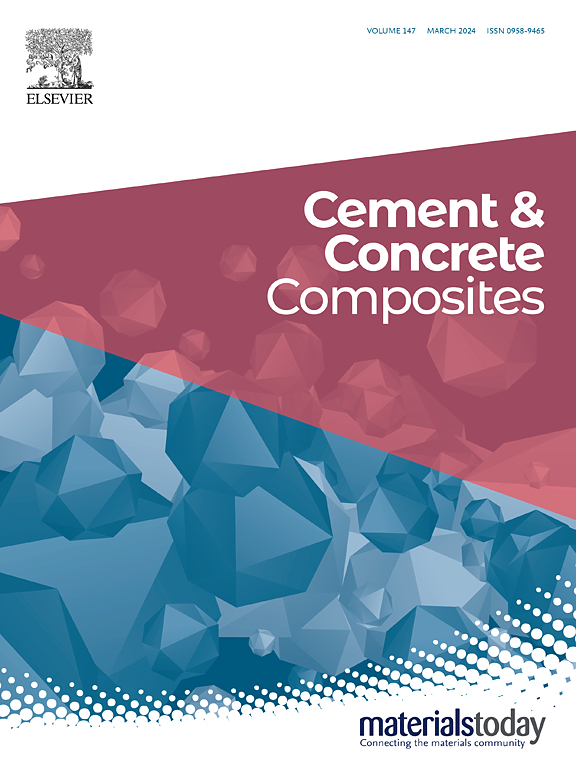Positive effects of sulfates on performance of cement paste incorporating low-grade, high-aluminum steel slag
IF 10.8
1区 工程技术
Q1 CONSTRUCTION & BUILDING TECHNOLOGY
引用次数: 0
Abstract
Steel slag with high aluminum (Al) content significantly delays the early hydration of cement when used as a supplementary cementitious material (SCM). To address this challenge, this study investigates the effects of gypsum (Gy) and sodium sulfate (SS) additions on the performance of cement pastes with 30 % high-Al ladle metallurgy furnace (LMF) slag. The mechanical properties, hydration kinetics, phase evolution, as well as the early-age hydration mechanism were explored. The results indicate that C3S hydration is substantially inhibited under high-Al conditions, mainly attributed to the rapid dissolution and reaction of reactive aluminates (particularly mayenite) in the slag. Both Gy and SS additions promote the early hydration of the blended pastes, albeit through distinct mechanisms. The addition of Gy tends to suppress mayenite dissolution, thereby mitigating the retardation of C3S hydration by postponing aluminum release; however, in sufficiently sulfated pastes (i.e., containing 15 % Gy), where renewed aluminate dissolution occurs after C3S hydration, delayed hydration of C3S compared to PC can still be observed. The addition of SS does not appear to affect mayenite dissolution due to the low calcium concentration; however, C3S hydration is not inhibited, as the high alkalinity mitigates the inhibitory effects of aluminum on C3S dissolution. Instead, SS promotes C3S hydration, primarily by increasing the ionic strength of the solution. Consequently, the addition of sulfate (particularly SS) enhances early-age (within 3 days) compressive strength of the blended pastes, while excessive sulfate addition can compromise late-age strength.
硫酸盐对低品位高铝钢渣水泥浆体性能的积极影响
高铝含量的钢渣作为辅助胶凝材料,显著延缓了水泥的早期水化。为了解决这一挑战,本研究研究了石膏(Gy)和硫酸钠(SS)的添加对30%高铝钢包冶金炉(LMF)渣水泥浆性能的影响。对其力学性能、水化动力学、相演化及早期水化机理进行了探讨。结果表明,在高铝条件下,C3S的水化作用明显受到抑制,这主要是由于活性铝酸盐(尤其是镁铝石)在渣中的快速溶解和反应。虽然通过不同的机制,但Gy和SS的添加都促进了混合膏体的早期水化。Gy的加入有抑制梅氏岩溶解的趋势,从而通过延缓铝的释放来减轻C3S水化的阻滞;然而,在充分硫酸化的膏体中(即含有15% Gy),在C3S水化后发生新的铝酸盐溶解,与PC相比,C3S的水化延迟仍然可以观察到。由于钙浓度较低,SS的添加不影响梅氏岩的溶解;但由于铝的高碱度减轻了铝对C3S溶解的抑制作用,没有抑制C3S的水化作用。相反,SS主要通过增加溶液的离子强度来促进C3S的水化。因此,硫酸盐(特别是SS)的加入提高了混合膏体的早期(3天内)抗压强度,而过量的硫酸盐添加会损害后期强度。
本文章由计算机程序翻译,如有差异,请以英文原文为准。
求助全文
约1分钟内获得全文
求助全文
来源期刊

Cement & concrete composites
工程技术-材料科学:复合
CiteScore
18.70
自引率
11.40%
发文量
459
审稿时长
65 days
期刊介绍:
Cement & concrete composites focuses on advancements in cement-concrete composite technology and the production, use, and performance of cement-based construction materials. It covers a wide range of materials, including fiber-reinforced composites, polymer composites, ferrocement, and those incorporating special aggregates or waste materials. Major themes include microstructure, material properties, testing, durability, mechanics, modeling, design, fabrication, and practical applications. The journal welcomes papers on structural behavior, field studies, repair and maintenance, serviceability, and sustainability. It aims to enhance understanding, provide a platform for unconventional materials, promote low-cost energy-saving materials, and bridge the gap between materials science, engineering, and construction. Special issues on emerging topics are also published to encourage collaboration between materials scientists, engineers, designers, and fabricators.
 求助内容:
求助内容: 应助结果提醒方式:
应助结果提醒方式:


